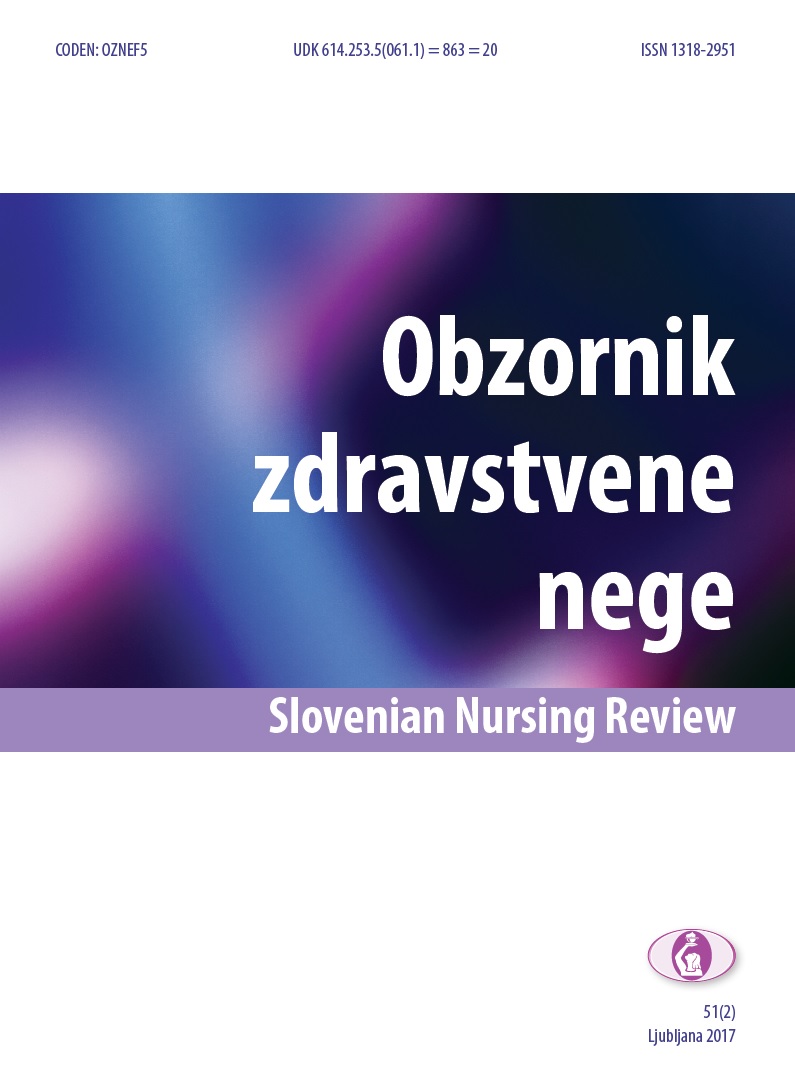The family medicine reference clinic: an example of interprofessional collaboration within a healthcare team
DOI:
https://doi.org/10.14528/snr.2017.51.2.179Keywords:
family medicine reference clinics, FMRC, nurses, family medicine practice, patient care protocolAbstract
Since being introduced in 2011, family medicine reference clinics (FMRCs) have created several advantages in the treatment of patients, but have also drawn attention to areas where improvements could be made (Poplas Susič, et al., 2013). Consistent with competencies and experts, each chronic patient care protocol as well as the prevention protocol strictly follows guidelines or recommendations that define diagnostic and treatment as well as education pathways for patient care in a family medicine practice. They are harmonised and agreed with experts at different levels of healthcare (primary, secondary and tertiary) (Vodopivec Jamšek, 2013).
Downloads
Metrics
References
Bender, M., 2017. Clinical nurse leader-integrated care delivery: an approach to organizing nursing knowledge into practice models that promote interprofessional, team-based care. Journal of Nursing Care Quality, 32(3), pp. 189–195. https://doi.org/10.1097/NCQ.0000000000000247 PMid: 28212166
Bowman, M.A., Neale, A.V. & Seehusen, D.A., 2016. Research in family medicine by family physicians for the practice of family medicine. The Journal of the American Board of Family Medicine, 29(4), pp. 427–429. https://doi.org/10.3122/jabfm.2016.04.160159
De Los Santos, M., Mcfarlin, C.D. & Martin, L., 2014. Interprofessional education and service learning: a model for the future of health professions education. Journal of Interprofessional Care , 28(4), pp. 374–375. https://doi.org/10.3109/13561820.2014.889102 PMid: 24571208
deGruy, F.V., Ewigman, B., Devoe, J.E., Hughes, L., James, P., Schneider, F.D., et al., 2015. A plan for useful and timely family medicine and primary care research. Family Medicine, 47(8), pp. 636–642. PMid:26382122
Fortin, M., Chouinard, M.-C., Bouhali, T., Dubois, M.-F., Gagnon, C. & Bélanger, M., 2013. Evaluating the integration of chronic disease prevention and management services into primary health care. BMC health services research, 13, art. ID 132. https://doi.org/10.1186/1472-6963-13-132
Greene, J., Hibbard, J.H. & Overton, V., 2014. A case study of a team-based, quality-focused compensation model for primary care providers. Medical Care Research and Review, 71(3), pp. 207–223. https://doi.org/10.1177/1077558713506749 PMid: 24227812
Klemenc-Ketiš, Z., Kravos, A., Poplas-Susič, T., Švab, I. & Kersnik, J., 2014. New tool for patient evaluation of nurse practitioner in primary care settings. Journal of clinical nursing, 23(9–10), pp. 1323–1331. https://doi.org/10.1111/jocn.12377 PMid: 24028310
Lea, J. & Cruickshank, M., 2017. The role of rural nurse managers in supporting new graduate nurses in rural practice. Journal of Nursing Management, 25, pp. 176–183. https://doi.org/10.1111/jonm.12453
Martínez-González, N.A., Djalali, S., Tandjung, R., Huber-Geismann, F., Markun, S., Wensing, M., et al., 2014.. Substitution of physicians by nurses in primary care: a systematic review and meta-analysis. BMC health services research, 14, art. ID 214. https://doi.org/10.1186/1472-6963-14-214 PMid: 24884763; PMCid: PMC4065389
Pečelin, S. & Sočan, M., 2016. Referenčne ambulante: izkušnje diplomiranih medicinskih sester. Obzornik zdravstvene nege, 50(2), pp. 157–162. http://dx.doi.org/10.14528/snr.2016.50.2.82
Petek, D. & Mlakar, M., 2016. Quality of care for patients with diabetes mellitus type 2 in ‘model practices’ in Slovenia–first results. Slovenian Journal of Public Health, 55(3), pp. 179–184. https://doi.org/10.1515/sjph-2016-0023 PMCid: PMC5031067
Petek Šter, M. & Šter, B., 2015. Pomen izobraževanja diplomiranih medicinskih sester v referenčnih ambulantah: primer arterijske hipertenzije. Obzornik zdravstvene nege, 49(1), pp. 52–59. http://doi.org/10.14528/snr.2015.49.1.46
Poplas Susič, T., Švab, I. & Kersnik, J., 2013. The project of model practices in family medicine in Slovenia. Zdravniški Vestnik, 82(10), pp. 635–647.
Poplas-Susič, T., Švab, I., Klančar, D., Petek, D., Vodopivec-Jamšek, V., Bulc, M., et al., 2015. Screening and registering patients with asthma and COPD in Slovenian primary care: first results. Zdravstveno Varstvo, 54(3), pp. 161–167. https://doi.org/10.1515/sjph-2015-0023 PMid: 27646723; PMCid: PMC4820152
Spiva, L., Hart, P.L., Patrick, S., Waggoner, J., Jackson, C. & Threatt, J.L., 2017. Effectiveness of an evidence-based practice nurse mentor training program. Worldviews on Evidence Based Nursing, in press, pp. 1–9. https://doi.org/10.1111/wvn.12219 PMid: 28334505
Vodopivec Jamšek, V., 2013. Protokol za vodenje kroničnega bolnika v referenčni ambulanti družinske medicine. Zdravniški vestnik, 82(11), pp. 711–717.
Downloads
Published
How to Cite
Issue
Section
License
As the author undersigned hereby, I transfer, assign, or otherwise convey the following authorship rights as comprised in the Copyright and Related Rights Act (CRRA) to the Slovenian Nursing Review, Ob železnici 30A, 1000 Ljubljana: the right of reproduction - the exclusive right to fix the work in a material medium or in another copy directly or indirectly, temporarily or permanently, by any means and in any digital form, in whole or in part (CRRA, Article 23); the right of distribution (CRRA, Article 24); the right of making a work available and accessible through the internet (CRRA, Article 32a); the right of transformation, especially the exclusive right to translate a pre-existing work (CRRA, Article 33). The transfer of author rights applies to the article in its entirety, including pictorial and/or graphic works and possible supplements. The transfer of rights is exclusive and unlimited in duration or territory.
























